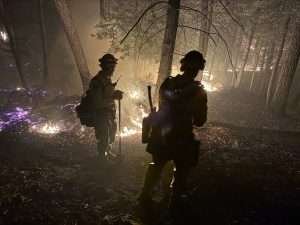
 Recent dry and windy conditions have resulted in numerous wildfires across New York State. There are currently six active fires that have burned more than 6,000 acres. New York State has issued a Drought Warning and Very High fire danger in some regions.
Recent dry and windy conditions have resulted in numerous wildfires across New York State. There are currently six active fires that have burned more than 6,000 acres. New York State has issued a Drought Warning and Very High fire danger in some regions.
Rangers remain on the scene of a 5,304-acre fire in the town of Warwick, Orange County. The Jennings Creek Fire, which straddles the New York and New Jersey border, is now 90 percent contained.
The Drought Warning has been issued for much of the Catskills, Hudson Valley, and New York City regions. The rest of the State remains under a previously declared Drought Watch.
Conditions continue to result in a “High” and “Very High” fire danger in certain regions. A high fire danger means all fine, dead fuels ignite readily and fires can start easily from most causes, including unattended brush and campfires.

 Fires may become serious and controlling them difficult, so attacking fires while still small is imperative.
Fires may become serious and controlling them difficult, so attacking fires while still small is imperative.
On Saturday, November 9, Forest Rangers responded to a fire measuring 21.5 acres in Riverhead in Suffolk County. The fire is currently in patrol status.
On Sunday, November 17, Forest Rangers responded to a 43-acre fire in Monroe in Orange County. The fire is now contained.
On Monday, November 18, Forest Rangers responded to a fire in the town of Denning, Ulster County, caused by debris burning that grew to 645 acres. The fire is now in patrol status.
Rangers also fully contained a 27-acre fire in Rochester, Ulster County and put out a small fire in Lake Luzerne in Warren County.
Rangers are leading the efforts on the Jennings Creek Fire with six state agencies (DEC, New York State Office of Parks, Recreation and Historic Preservation, New York State Division of Homeland Security and Emergency Services, New York State Police, New York State Department of Corrections and Community Supervision, and New York Army National Guard), U.S. Fish and Wildlife, dozens of volunteer fire departments from across the state, and 18 wildland firefighters from Montana.

 Statewide Burn Ban
Statewide Burn Ban
An updated fire danger map is available on the DEC website.
Governor Kathy Hochul issued a statewide burn ban, which is in effect until November 30, 2024.
This burn ban prohibits the starting of outdoor fires statewide for purposes of brush and debris disposal, as well as uncontained campfires, and open fires used for cooking.
Backyard fire pits and contained campfires less than three feet in height and four feet in length, width, or diameter are allowed, as are small, contained cooking fires.
Burning garbage or leaves is prohibited year-round in New York State. Several municipalities also have burn bans in effect.
For more information about fire safety and prevention, go to DEC’s Firewise New York webpage.

 Drought Warning
Drought Warning
A “warning” is the second of four levels of state drought advisories (“watch,” “warning,” “emergency” and “disaster”). There are no statewide mandatory water use restrictions in place under a drought watch or warning but citizens are strongly encouraged to voluntarily conserve water.
Local public water suppliers may impose water use restrictions depending upon local needs and conditions.
To protect water resources, homeowners in regions under the drought watch or drought warning are encouraged to voluntarily reduce water use and follow these tips:
- Reuse water collected in rain barrels, dehumidifiers or air conditioners to water plants.
- Use a broom, not a hose, to clean driveways and sidewalks.
- Fix leaking pipes, fixtures, toilets, hoses and faucets.
- Wash only full loads of dishes and laundry.
- Take shorter showers or fill the bathtub partly.
- Install water saving plumbing fixtures.
- Don’t run the tap to make water hot or cold.
- Wash cars less frequently.
New York State Department of Health is in contact with public water suppliers to convey any potential steps they need to take. For water wells that may be affected by drought:
- Contact a registered water well contractor to discuss appropriate options for your individual situation.
- Check that the well is dry due to drought and no other issues. Sometimes the solution is quite simple, like a broken valve or electrical issue. The only way to definitively tell if a well is dry is to measure the water level in the well.
- Conserve water year-round to help prevent the effects of drought on water wells.
- Consider adding a water storage tank to help get through dry periods.
- Clean or redevelop existing wells.
- Deepen existing wells or drill a new well. If drilling a new well, properly decommission the old well to protect groundwater quality.
Photos of Jennings Creek fire in Warwick provided by DEC.



Recent Comments